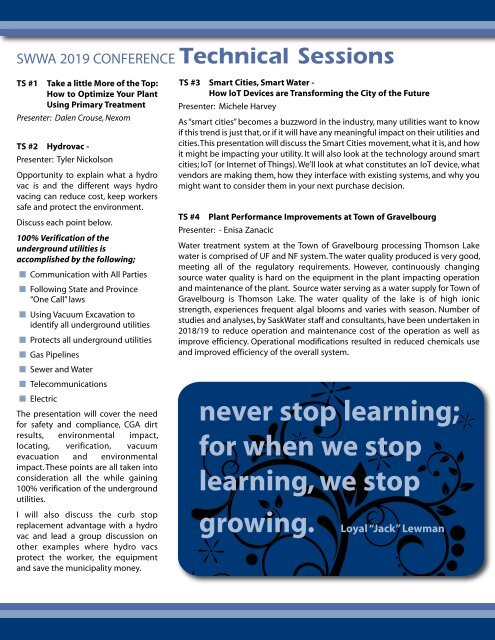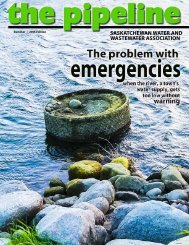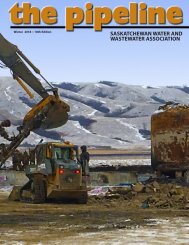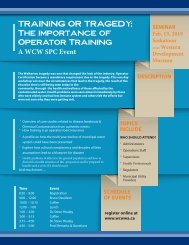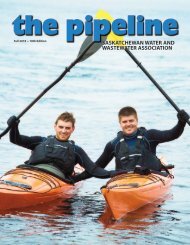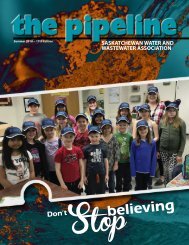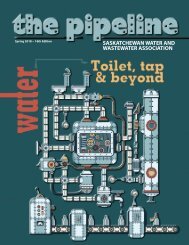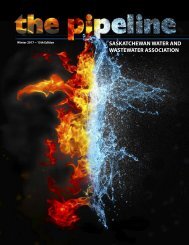2019 Fall Newsletter
You also want an ePaper? Increase the reach of your titles
YUMPU automatically turns print PDFs into web optimized ePapers that Google loves.
SWWA <strong>2019</strong> CONFERENCE Technical Sessions<br />
TS #1 Take a little More of the Top:<br />
How to Optimize Your Plant<br />
Using Primary Treatment<br />
Presenter: Dalen Crouse, Nexom<br />
TS #2 Hydrovac -<br />
Presenter: Tyler Nickolson<br />
Opportunity to explain what a hydro<br />
vac is and the different ways hydro<br />
vacing can reduce cost, keep workers<br />
safe and protect the environment.<br />
Discuss each point below.<br />
100% Verification of the<br />
underground utilities is<br />
accomplished by the following;<br />
n Communication with All Parties<br />
n Following State and Province<br />
“One Call” laws<br />
n Using Vacuum Excavation to<br />
identify all underground utilities<br />
n Protects all underground utilities<br />
n Gas Pipelines<br />
n Sewer and Water<br />
n Telecommunications<br />
n Electric<br />
The presentation will cover the need<br />
for safety and compliance, CGA dirt<br />
results, environmental impact,<br />
locating, verification, vacuum<br />
evacuation and environmental<br />
impact. These points are all taken into<br />
consideration all the while gaining<br />
100% verification of the underground<br />
utilities.<br />
I will also discuss the curb stop<br />
replacement advantage with a hydro<br />
vac and lead a group discussion on<br />
other examples where hydro vacs<br />
protect the worker, the equipment<br />
and save the municipality money.<br />
TS #3 Smart Cities, Smart Water -<br />
How loT Devices are Transforming the City of the Future<br />
Presenter: Michele Harvey<br />
As “smart cities” becomes a buzzword in the industry, many utilities want to know<br />
if this trend is just that, or if it will have any meaningful impact on their utilities and<br />
cities. This presentation will discuss the Smart Cities movement, what it is, and how<br />
it might be impacting your utility. It will also look at the technology around smart<br />
cities; IoT (or Internet of Things). We’ll look at what constitutes an IoT device, what<br />
vendors are making them, how they interface with existing systems, and why you<br />
might want to consider them in your next purchase decision.<br />
TS #4 Plant Performance Improvements at Town of Gravelbourg<br />
Presenter: - Enisa Zanacic<br />
Water treatment system at the Town of Gravelbourg processing Thomson Lake<br />
water is comprised of UF and NF system. The water quality produced is very good,<br />
meeting all of the regulatory requirements. However, continuously changing<br />
source water quality is hard on the equipment in the plant impacting operation<br />
and maintenance of the plant. Source water serving as a water supply for Town of<br />
Gravelbourg is Thomson Lake. The water quality of the lake is of high ionic<br />
strength, experiences frequent algal blooms and varies with season. Number of<br />
studies and analyses, by SaskWater staff and consultants, have been undertaken in<br />
2018/19 to reduce operation and maintenance cost of the operation as well as<br />
improve efficiency. Operational modifications resulted in reduced chemicals use<br />
and improved efficiency of the overall system.<br />
never stop learning;<br />
for when we stop<br />
learning, we stop<br />
growing.<br />
Loyal “Jack” Lewman<br />
TS #5 What's going on in your<br />
system?<br />
Using Electronic Tools for<br />
Utility Management-<br />
Presenter: Rui(Ray) Li<br />
The Management of a utility is a<br />
complicated endeavor that requires<br />
information from many sources so<br />
that you can make good decisions and<br />
demonstrate that you are providing a<br />
high quality product and great service<br />
with highly efficient operations.<br />
Reporting of results is an increasingly<br />
important part of transparent<br />
operations and typically includes<br />
documentation of key performance<br />
indicators (KPI’s) that are measured<br />
and tracked. These performance<br />
measures are crafted to summarize<br />
the details required in knowing how<br />
the system is operating, how you are<br />
taking care of the systems and<br />
equipment including the<br />
refurbishment, replacement, repair<br />
and planning of these activities as well<br />
as the smart use of resources such as<br />
financial expenditures and manpower<br />
allocations.<br />
How do you roll this all together in a<br />
manner that makes sense? The Asset<br />
Management approach that will be<br />
reviewed will include not just asset<br />
information but also how the<br />
feedback loop goes one step further<br />
so that it includes tradesperson’s time,<br />
parts and supplies in the warehouse<br />
for maintenance planning purposes.<br />
Other systems and practices that will<br />
be discussed are how the team<br />
integrated SCADA, operational and<br />
laboratory data to help Managers<br />
make operational decisions and<br />
reporting easier. The presentation will<br />
also provide an overview of the robust<br />
document control system that is<br />
essential to knowing how to find this<br />
information, as having great<br />
documentation is not helpful if<br />
employees can’t find it.<br />
TS #6 I ZINC WE HAD A TOXIC EVENT<br />
Presenters: Shauna Karakochuk & Kayla Gallant<br />
In October of 2018, the Regina Wastewater Treatment Plant experienced a significant<br />
toxic event. This event resulted in a substantial shift in biological populations, and<br />
the degradation of the effluent quality – which includes Total Phosphorus, E. coli, and<br />
Total Suspended Solids. The presentation highlights the investigative process used<br />
to determine the cause of the event, the immediate impacts within hours, the<br />
moderate impacts within weeks, and the lasting impacts within months of the toxic<br />
event.<br />
As a result of the toxic event, there were 13 different process functions that were<br />
analyzed as a part of the investigation. The investigative measures taken were<br />
necessary to provide our client, the City of Regina, a comprehensive report outlining<br />
the details of why the event impacted the final effluent quality. Throughout the<br />
investigation, extensive laboratory data was collected, analyzed, and reviewed,<br />
literature reviews were conducted, and outside experts were consulted.<br />
During the investigation, it became apparent that there was insufficient experience<br />
and published information available regarding a full scale toxic event within a<br />
biological nutrient removal plant. Other than hearsay information, we did not find<br />
any precedent for an event like ours. To determine the cause, impact, and details of<br />
this toxic event, we were required to complete extensive research using information<br />
from multiple technical and research sources.<br />
In conclusion, each individual reaction to the event was thoroughly understood, and<br />
this was significant enough to draw the firm conclusion of Zinc toxicity.<br />
. . . having great documentation is not helpful<br />
if employees can’t find it.


